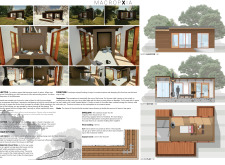5 key facts about this project
The structure is characterized by extensive use of natural materials, primarily wood, which serves as both the exterior cladding and structural element through cross-laminated timber (CLT). Glass plays a significant role in the design, facilitating natural light and views while maintaining a strong visual connection with the forest. The layout avoids internal doors, prioritizing open, interconnected spaces that enhance the overall flow and functionality. The design incorporates multifunctional furniture, allowing for adaptability in usage and efficient use of space.
Unique Architectural Approaches
One of the distinguishing features of MacroPxia is its focus on passive energy systems. The project utilizes solar panels to capture energy, significantly reducing reliance on external power sources. Additionally, a rainwater collection system is integrated into the design, promoting sustainability and environmental responsibility. This thoughtful approach to resource management is a key component of the architecture.
The architectural strategy integrates the building with the landscape, respecting existing topography and vegetation. This results in a structure that is both visually unobtrusive and functionally adaptive to its environment. The use of natural materials aligns with the overall aesthetic, creating a seamless transition from indoors to outdoors. Importantly, the design serves not only as a shelter but also as a space that enhances the human experience in nature, reflecting a deeper understanding of environmental design principles.
Structural and Functional Components
The structural composition relies heavily on CLT, which offers durability while minimizing environmental impact through its renewable nature. The warm wood cladding provides an appealing contrast to the surrounding greenery, while concrete foundations contribute to stability. Interior spaces are articulated with handcrafted joinery and built-in storage solutions, minimizing clutter and maximizing usability.
Furniture design within MacroPxia is also noteworthy. The central piece serves multiple purposes, seamlessly transitioning into different functions as required. This adaptive approach to design caters to the contemporary need for flexible living spaces, particularly relevant in today’s residential trends.
The MacroPxia project stands as a pragmatic example of modern architecture that prioritizes sustainability, functionality, and aesthetic coherence with nature. For those interested in exploring the architectural plans, sections, and detailed designs of MacroPxia, further investigation can provide deeper insights into the design concepts and methodologies employed in this project.























